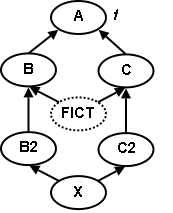Multiple constraints
Contents
Description
This article discusses issues which arise in conjunction with multiple constrained type parameters.
New multiple constraints for generic parameters
With the new ECMA standard for Eiffel multiple constraints for type parameters were introduced.
|
Example: class C [G -> {A, B }] end |
Class C expects a type parameter that conforms to B and C.
Explanation of the issue
Consider this example inheritance hierarchy together with the following code:

|
Example: class GENERIC_CLASS [G -> {B, C}] feature f: G h (g: G) is do -- something end example is do f.a -- qualified feature call end end |
Let's first have a look at the qualified feature call f.a of the example feature. The standard defines in section 8.12.23 what the base type of such a multiple constrained type parameter is. It is a fictive class (denoted as a dashed class FICT in the diagramm) which inherits from all constraint classes and to which a possible renaming is applied. Dynamic binding requires a clear notion of what the static type of a target (here f) is. Because to obtain the correct feature one needs the static and dynamic type of the target at runtime. One normally would take the base type of the target as the static type. But we cannot take this fictive base type as our static type because, as can be seen in the diagram, he is outside of the conformance paths to X and therefore not usable with the current definition of dynamic binding in section 8.16.11.
If B and/or C redefine the feature f the problem is resolved by renaming and one can chose for which conformance path the feature is called. If until the level of {B,C} no redefinition of feature f has occured, the decision which static type to use is getting more complicated: The feature f could for exmaple be redefined in B2 and/or C2. In that case X would then have to select one of them. This yields is an ambiguity which the current ECMA Standard (version 2) does not resolve because no proper definition for the static type is given in this case.
One would also be unnable to pass an argument to feature h, because no class (except possibly NONE) conforms to the fictive base type FICT
The definition of this fictitious type FICT can only be used to clearly define the set of available features to instances of type G. It can not be used to define the semantic of a qualified feature call (like f.a).
Proposed semantic:
One possible solution is the following: If we have a multiple constrained type parameter and a qualified feature call on a target of that type, we define the static type to be the type of the class which introduced the current version of the called feature body. This must be a common ancestor of the constraining classes which contain the feature f (in our case B and C).
In our example we would set the static type of f to A and then execute the qualified feature call.
This is somehow reasonable because if there would not be any children, we would execute the feature f defined in A. If we set the static type to A we ensure that whatever occurs to f we will always execute the feature which the programmer selects to be the right feature for static type A.

